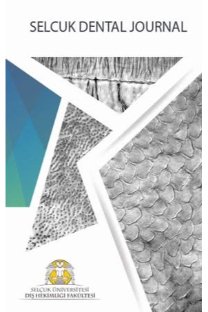İki farklı porselen laminate veneer restorasyonun kenar uyumunun in-vitro olarak değerlendirilmesi+
In-vitro evaluation of marginal adaptation of two different porcelain laminate veneers
___
- 1. Berksun S, Kedici PS, Kalıpcılar B. A matrix procedure for reproducing natura lor carved tooth contours in porcelain laminate veneers. J Prosthet Dent 1994; 71: 203-5.
- 2. Brunton PA, Wilson NHF. Preparations for porcelain laminate veneers in general practice. Br Dent J 1998; 184: 553-6.
- 3. Ermiş B. Seramik laminate veneerlerin klinik değerlendirmesi: 1 yıllık sonuçlar. Ankara Üniv Dişhek Fak Derg 2003; 30: 115-23.
- 4. Sim C, Ibbetson RJ. Comparision of fit of porcelain veneers fabricated using different techniques. Int J Prosth 1993: 6: 36-42.
- 5. Trushkowsky RD. Accurate Provisional Cementation: Prelude to an Esthetic Ceramic Restoration. Contemporary Esthet 1999: 21: 80-4.
- 6. Aphold W, Bindl A, Luthy H. Flexural Strength of Cerec 2 Machined and Jointed Inceram-Alumina and InceramZirconia. Dent Mater 2001: 17; 260-7.
- 7. Akbar JH, Petrie CS, Walker MP, Williams K, Eick JD. Marginal Adaptation of Cerec 3 CAD/CAM Composite Crowns using Two Different Finish Line Preparation Designs, J Prosthodont 2006; 15, 155-63.
- 8. Gürel G. Porselen Laminate Venerler Bilim Ve Sanatı, Quintessence Yayıncılık Ltd. Şti, İstanbul, (2004).
- 9. Walls AWG, Wassel RW. Crowns and Other Extra Coronal Restorations: Porcelain Laminate Veneers. Br Dental Journal 2002; 193: 73-82.
- 10. Diren A. Sabit restorasyonlarda marginal uyum ölçümünün önemi. Hacc Dis Hek Fak Derg. 1994; 18: 53-5.
- 11. Abbate FM, Tjan AHL, Dent D. Comparison of the marginal fit of various ceramic crown systems. J Prosthet Dent 1989; 61: 527-31.
- 12. Lui JL. The effect of fiting shrinkage on the marginal fit of porcelain jacket crowns. Br Dent J 1980; 149: 43-5.
- 13. Mc Laren EA, White SN. Glass-infiltrated zirconia/ alumina-based ceramic for crowns and fixed partial dentures:cilinical and laboratory guidelines. Quintessence Dent Techn 2000; 23: 63-276.
- 14. Karlsson S. The fit of Procera titanium crowns. An in vitro and clinical study. Acta Odontol Scand 1993;51: 129-34.
- 15. Weaver JD, Johnson GH, Bales DJ. Marginal adaptation of castable ceramic crowns. J Prosthet Dent 1991;66: 747- 53.
- 16. McLean JW, Von Fraunhofer JA. The estimation of cement film thickness by an in vivo technique. Br Dent J 1971;131:107-11.
- 17. Kashani HG, Khera SC, Guker IA. The effects of bevel angulation on marginal integrity. J Am Dent Assoc 1981; 103: 882-85.
- 18. Castelnuovo J, Tjan AHL, Phillips K, Nicholls JI, Kois JC. Fracture Load and Mode of Failure of Ceramic Veneers with Different Preparations. J Prosthet Dent 2000; 83: 171-80.
- 19. Cleyde JS, Gilmour A. Porcelain Veneers: A Preliminary Review. Br Dent J 1988; 164: 9-14.
- 20. Giordano RA. Dental ceramic restorative systems. Compendium 1996; 17: 779-94.
- 21. Vahidi F, Egloff ET, Pano FV. Evaluation of marginal adaptation of all ceramic crowns and metal ceramic crowns. J Prosthet Dent 1991; 66: 426-31.
- 22. Reich S, Wichmann M, Nkenke E, Proeschel P. Clinical fit of allceramic three unit fixed partial dentures,generated with three different CAD/CAM systems. Eur J Oral Sci 2005; 113: 174-79.
- 23. Stappert FJ, Dai M, Chitmongkolsuk S, Gerds T, Strub JR. Marginal adaptation of three-unit fixed partial dentures constructed from pressed ceramic systems. Br Dent J 2004;196: 766-70.
- 24. Alani AH, Toh CG. Detection of microleakage around dental restorations: A review. Oper Dent 1997; 22: 173- 85.
- 25. Bindl A, Mormann WH. Clinical Evaluation of Adhesively Placed Cerec Endo-Crowns After 2 Years-Preliminary Results. J Adhes Dent 1999; 1: 255-65.
- 26. Sato K, Matsumura H, Atsuta M. Relation between Cavity Design and Marginal Adaptation in a Machine-Milled Ceramic Restorative System. J Oral Rehabil 2002; 29: 24-7.
- 27. Nakamura T, Dei N, Kojima T. Marginal and Internal Fit of Cerec 3 CAD/CAM All-Ceramic Crowns. Int J Prosthodont 2003; 16: 244-8.
- 28. Bindl A. Mörmann WH. An up to 5-year clinical evaluation of posterior In-Ceram CAD/CAM core crowns. Int J Prosthodont 2002; 15: 451-56.
- 29. Üçtaşlı S, Wilson HJ, Unterbrink G, Zaimoğlu A. The strength of a heat-pressed all-ceramic restorative material. J Oral Rehabil 1996; 23: 257-61.
- 30. Persson M, Andersson M, Bergman B. The accuracy of a highprecision digitizer for CAD/CAM of crowns. J Prosthet Dent 1995; 74: 223-29.
- 31. Apholt W, Bindl A, Luthy H. Flexural Strength of Cerec 2 Machined and Jointed Inceram-Alumina and InceramZirconia. Dent Mater 2001; 17: 260-7.
- 32. Pallesen U, Van Dijken JW. An 8-Year Evaluation of Sintered Ceramic and Glass Ceramic Inlays Processed by The Cerec CAD/CAM System. Eur J Oral Sci 2000; 108: 239-46.
- 33. Hunter AJ, Hunter AR. Gingival crown margin configurations: a review and discussion. Part I: Terminology and widths. J Prosthet Dent 1990; 64: 548-52.
- 34. Sorensen JA, Okamoto SK, Seghi RR, Yarovesky U. Marginal fidelity of four methods of swaged metal matrix crown fabrication. J Prosthet Dent 1992; 67: 162-73
- ISSN: 1300-5170
- Yayın Aralığı: Yılda 3 Sayı
- Başlangıç: 1991
- Yayıncı: İsmail Marakoğlu
Toplumumuzda diş ipi kullanma alışkanlığı
In vitro evaluation of marginal leakage using various temporary filling materials
Ayçe ELDENİZ ÜNVERDİ, MAKBULE BİLGE AKBULUT, MEHMET BURAK GÜNEŞER
Zirkonya: Yapısı ve altyapı üretim tekniği
Obezitenin tükürük PH'sı, tamponlama kapasitesi ve diş çürüğü insidansı'na etkisi+
Abdulkadir ŞENGÜN, NAZMİYE DÖNMEZ, İsmet DURAN, H.Esra ÜLKER
İki farklı porselen laminate veneer restorasyonun kenar uyumunun in-vitro olarak değerlendirilmesi+
MERAL ARSLAN MALKOÇ, Atiye Nilgün ÖZTÜRK, Şerife Tuba BÜYÜKÖZER, Bora ÖZTÜRK
Leyla B. AYRANCI, Hakan ARSLAN, H. Sinan TOPÇUOĞLU
Betül GÜNEŞ, Hale AYDINBELGE ARI
Hakan ARSLAN, Çağatay BARUTCİGİL, Duygu KÜRKLÜ, Hüseyin ERTAŞ
Tooth shade assessment after lingual retainer application: A prospective clinical trial
Hasan Önder GÜMÜŞ, Faruk İzzet UÇAR, Hayriye ŞENTÜRK, Tancan UYSAL
